Georgia State Capitol
|
Georgia State Capitol | |
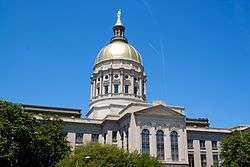 East side (rear) of The Georgia State Capitol | |
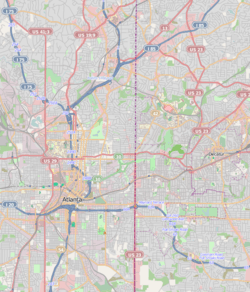   | |
| Location | Atlanta, Georgia |
|---|---|
| Coordinates | 33°44′56″N 84°23′17″W / 33.7490°N 84.3881°WCoordinates: 33°44′56″N 84°23′17″W / 33.7490°N 84.3881°W |
| Built | 1889 |
| Architect | Edbrooke and Burnham[1] |
| Architectural style | Renaissance, Classical Revival[1] |
| NRHP reference # | 71001099 |
| Significant dates | |
| Added to NRHP | December 9, 1971[1] |
| Designated NHL | November 7, 1973[2] |
The Georgia State Capitol is an architecturally and historically significant building in Atlanta, Georgia, United States. It has been named a National Historic Landmark and is listed on the National Register of Historic Places. It is the primary office building of Georgia's government housing the offices of the governor, lieutenant governor, and secretary of state on the second floor, and on the third floor, chambers in which the General Assembly, that consists of the Georgia State Senate and Georgia House of Representatives which meets annually from January to April. The fourth floor houses visitors' galleries overlooking the legislative chambers and a museum. A statue of Miss Freedom caps the dome.
History
The capitol site was occupied previously by the first Atlanta City Hall. To encourage the state government to relocate the capital city to rapidly growing and industrialized Atlanta from rural Milledgeville, the city donated the site. The first capitol in Louisville no longer stands, while in Augusta and Savannah the legislature met in makeshift facilities, perhaps causing (or caused by) the alternation of those two cities as capital. The legislature also met at other places, including Macon, especially during and just after the Atlanta Campaign of the American Civil War.
Architecture
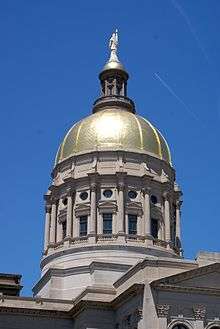
Like many U.S. state capitols, the Georgia State Capitol is designed to resemble the Neoclassical architectural style of the United States Capitol, in Washington, D.C. Former Confederate general Philip Cook. was a member of the commission that oversaw planning and construction of the building. The commission engaged architects Willoughby J. Edbrooke and Franklin Pierce Burnham, of Chicago to design the building and Miles and Horne of Toledo, Ohio for construction. Work completed in March 1889. Sculptor George Crouch executed all the ornamental work on the building.
The Capitol faces west on Washington Street. The façade features a four-story portico, with stone pediment, supported by six Corinthian columns set on large stone piers. Georgia's coat of arms, with two figures on each side, is carved on the pediment. The Capitol's interior represents the 19th-century style of its time. It was among the earliest buildings to have elevators, centralized steam heat, and combination gas and electric lights. Classical pilasters and oak paneling are used throughout the building. The floors of the interior are marble from Pickens County, which still produces marble today.
The open central rotunda is flanked by two wings, each with a grand staircase and three-story atrium crowned by clerestory windows. The Capitol building has undergone frequent renovations to adapt to the growth and change of government. Originally constructed from terra cotta and covered with tin, in a 1958 renovation[3] the present dome was gilded with native gold leaf from near Dahlonega in Lumpkin County, where the first American gold rush occurred during the 1830s. For this reason, legislative business is often referred to as what is happening "under the Gold Dome" by media across the state. The statue Miss Freedom has adorned the dome since the building's opening.
In 1997, the House and Senate chambers were restored to their 1889 appearance with replicated decoration and color schemes. This included the demolition of damaged plaster, the reinstallation of flat plaster at the dome, columns, and walls, and a decorative painting in the House and Senate Chambers.[2][4]
Georgia Capitol Museum

The museum within the Capitol, in existence since 1889, houses extensive collections representing the natural and cultural history of Georgia. Native American artifacts, animals, rocks and minerals, and fossils illustrate the diversity of the collections. Removed during restoration or renovation, most of the collection remains in storage. The portraits of governors, statues of famous Georgians, and historic flags from many wars are displayed throughout the Capitol. The portraits of all governors elected since 1850 are there, except for Rufus Bullock.[5]
The Georgia Capitol Museum is a public education institution housed in the Capitol building under the administration of the University of Georgia Libraries. The museum seeks to preserve and interpret the history of the Georgia Capitol in Atlanta, the functions of the government, and the events that have occurred in the Capitol. To accomplish this, the museum collects, preserves, and interprets artifacts relating to the Capitol or associated with the events that have occurred there.
Dimensions
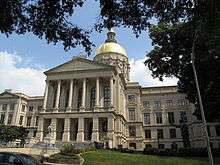
- Greatest north–south: 347 feet, 9 inches (105.99 meters)
- Greatest central depth: 272 feet, 4.5 inches (83.02 meters)
- Second-Floor Rotunda to ceiling: 187 feet, 4 inches (57.10 meters)
- Dome diameter: 75 feet (22.86 meters)
Monuments on the Capitol grounds
- Statue of Benjamin Harvey Hill (Confederate Senator, US Senator and US Representative).[6]
- Statue of Joe Brown and his wife. "Brown was the Confederate governor of Georgia and after the war served as [U.S.] senator. He also was an ardent secessionist who played on white fears of interracial mingling. After the war, Brown served briefly as chief justice of the Georgia Supreme Court and authored an opinion upholding the state's ban on interracial marriage that described such marriages as 'productive of evil, and evil only, without any corresponding good.'... That opinion was cited in several briefs in the Supreme Court's recent decision on gay marriage as an example of how government has consistently erred in defining marriage."[7]
- Expelled Because of Their Color, a 6 feet (1.8 m) bronze statue, by John Thomas Riddle, Jr., on the Capitol grounds.[8] It was commissioned in 1976 by the Georgia Legislative Black Caucus, and unveiled in 1978. The statue commemorates the Original 33, the 33 African-American legislators who were expelled from the Georgia legislature in 1868.
- Plaque and tree honoring William Ambrose Wright, a lieutenant in the Confederate States Army, and Georgia state comptroller for fifty years, as well as insurance commissioner. Erected by the Atlanta Ladies Memorial Association, January 19, 1930.[9]
- Sculpture of Ellis Arnall, Attorney General and then Governor of Georgia, 1943–1947. "Arnall is remembered for a progressive and reform-minded administration." Erected November 24, 1997.[10]
- Governors
- Governor and CSA Gen. John Brown Gordon Memorial; erected in 1907, a year after the Atlanta Race Riot. "One of the leading proponents of both the New South creed and the Lost Cause, a philosophy that greatly romanticized the South's role in the war. Moreover, he is generally acknowledged as having been the head of the Ku Klux Klan in Georgia. Gordon defended slavery as 'morally, socially and politically right' and called the Klan 'a brotherhood of peaceable, law-abiding citizens.'"[7]
- Joseph E. Brown (also US Senator) and Elizabeth Brown (1928)
- Eugene Talmadge (1949)
- Richard B. Russell (also a US Senator) (1975). "According to the book Richard B. Russell, Jr., Senator from Georgia, Russell at one time stated that 'it was an insult to the people of Georgia...to even insinuate that I stand for political and social equality with the negro.'"[11]
- Herman Talmadge (also a US Senator) (1990)
- Jimmy Carter (also a US President) (1992)
- Ellis Arnall (1997)
- Others
- US Coast Guard Survey History Marker (1874)
- Reproduction of the Liberty Bell (1950)
- Statue of Liberty replica (1951)
- Spanish War Veterans Memorial (1967)
- Flame of Freedom (American Legion) (1969)
- Expelled Because of Their Color (1978) (also listed above)
- DogNY Project Sculpture (2002)
- Vietnam War Memorial (1979)
- Bronze sculpture of Martin Luther King (2017)[12]
- Statue removed
- Thomas Edward Watson (1932) (US Senator and US Representative). In 2013, Governor Nathan Deal ordered the statue moved across the street to Park Plaza.[13]
Georgia's Old Capitol Museum
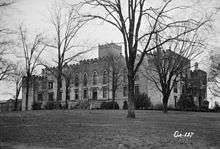
Georgia's second capitol building is at 201 East Greene Street, Milledgeville, Georgia, and served as state capitol from 1807 until 1867. The building was severely damaged by a fire March 24, 1941[14] and was rebuilt in its former design to serve as a part of Georgia Military College.[15] The first floor of the old capitol is open as a museum.
Appearances
Some parts of filming of the premier episode of the ninth season of the television show The Walking Dead were filmed around and within the Georgia State Capitol over a period of two days.[16]
See also
References
- 1 2 3 "National Register of Historical Places - Georgia (GA), Fulton County". National Register of Historic Places. National Park Service. February 25, 2007.
- 1 2 "State Capitol Building (Georgia)". National Historic Landmark summary listing. National Park Service. Archived from the original on January 31, 2009. Retrieved May 1, 2008.
- ↑ Jackson, Edwin L. (September 11, 2014). Georgia State Capitol. New Georgia Encyclopedia.
- ↑ Crimmins, Timothy; Farrisee, Anne (2007). Democracy Restored: A History of the Georgia Capitol. University of Georgia Press. ISBN 978-0820329116.
- ↑ Atlanta Journal Constitution article
- ↑ Corson, Pete. "Photos: Confederate memorials in metro Atlanta". Atlanta Journal-Constitution. Retrieved May 25, 2018.
- 1 2 Joyner, Chris (September 5, 2015). "Georgia Capitol heavy with Confederate symbols". Atlanta Journal-Constitution. Retrieved May 25, 2018.
- ↑ "Expelled Because of Their Color". Atlanta PlanIt (Public Broadcasting Atlanta). Retrieved September 8, 2018.
- ↑ "Fulton County Historical Markers. To the Memory of William Ambrose Wright". GeorgiaInfo, an online Georgia almanac. Digital Library of Georgia. Retrieved September 10, 2018.
- ↑ "This Day in Georgia History. November 24, 1997. Ellis Arnall Statue Dedicated". GeorgiaInfo, an online Georgia almanac. Digital Library of Georgia. Retrieved September 10, 2018.
- ↑ Klein, Rebecca (January 15, 2014). "Yes, Schools In The U.S. Still Bear The Names Of White Supremacists". Huffington Post.
- ↑ Atlanta Curbed
- ↑ Torres, Kristina (November 29, 2013). "Tom Watson's statue removed from Georgia's Capitol steps". Atlanta Journal-Constitution.
- ↑ HABS Survey GA-137
- ↑ Edwin L. Jackson. Carl Vinson Institute of Government. The University of Georgia. The story of Georgia's capitols and capital cities Archived October 9, 2007, at the Wayback Machine..
- ↑ Ross, Dalton (October 6, 2018). "The Walking Dead director answers season premiere burning questions". Entertainment Weekly. Retrieved October 6, 2018.
External links
| Wikimedia Commons has media related to Georgia State Capitol. |

